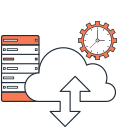analytics models of Big Data
It helps improve Email ROI!
1
Clustering
Clustering tells a story about who your consumer is by grouping similar customers together. With clustering you let the algorithms, rather than the marketers, create customer segments. Algorithms are able to segment customers based on many more variables than a human being ever could. Clustering is not the end all and be all of data modelling. Once you have the customers grouped into “like�? behavioral groups, you then can look deeper at the data to determine how good a customer/prospect they truly are, based on numerous signals.
Let’s explore a few of these and see how deep we can go.
Long term, high value, frequent buyers
- $99 average order
- $2,261 total revenues
- 24 days between orders
+ 10 More
High value, fewer orders, big spend on 1st order
- $124 average order
- $595 total revenues
- 67 days between orders
+ 10 More
2
Propensity models
Propensity models make predictions about a customer’s future behavior. With propensity models you can anticipate a customer’s possible future behavior. The certainty of action however is a prediction and you have to gauge the degree of certainty. You could use this to analyze your subscribers’ propensity to engage, propensity to unsubscribe, propensity to buy in a specific product or service category, churn, etc.
3
Recommendation or Collaborative Filtering
These recommendation models were made famous by Amazon with their “customer who liked this product, also liked …�? suggestions. There are different types of
recommendations. You could use the same for upselling or cross selling products
in your order confirmation or transactional emails which can have a high open and engagement rate well above promotional communication.
For all of us who are email marketers, we need specific email data types for better targeted campaigns!
So, which are those? CTOR, Purchase Histories and Browsing Behavior, may be?














